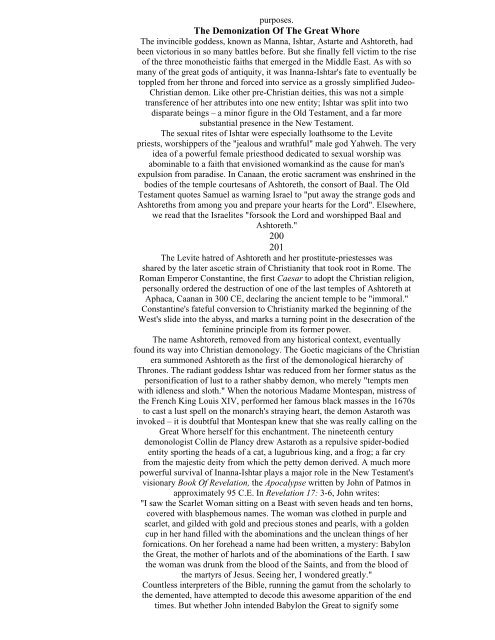I. VAMA MARGA Foundations Of The Left-Hand Path - staticfly.net
I. VAMA MARGA Foundations Of The Left-Hand Path - staticfly.net
I. VAMA MARGA Foundations Of The Left-Hand Path - staticfly.net
Create successful ePaper yourself
Turn your PDF publications into a flip-book with our unique Google optimized e-Paper software.
purposes.<br />
<strong>The</strong> Demonization <strong>Of</strong> <strong>The</strong> Great Whore<br />
<strong>The</strong> invincible goddess, known as Manna, Ishtar, Astarte and Ashtoreth, had<br />
been victorious in so many battles before. But she finally fell victim to the rise<br />
of the three monotheistic faiths that emerged in the Middle East. As with so<br />
many of the great gods of antiquity, it was Inanna-Ishtar's fate to eventually be<br />
toppled from her throne and forced into service as a grossly simplified Judeo-<br />
Christian demon. Like other pre-Christian deities, this was not a simple<br />
transference of her attributes into one new entity; Ishtar was split into two<br />
disparate beings – a minor figure in the Old Testament, and a far more<br />
substantial presence in the New Testament.<br />
<strong>The</strong> sexual rites of Ishtar were especially loathsome to the Levite<br />
priests, worshippers of the "jealous and wrathful" male god Yahweh. <strong>The</strong> very<br />
idea of a powerful female priesthood dedicated to sexual worship was<br />
abominable to a faith that envisioned womankind as the cause for man's<br />
expulsion from paradise. In Canaan, the erotic sacrament was enshrined in the<br />
bodies of the temple courtesans of Ashtoreth, the consort of Baal. <strong>The</strong> Old<br />
Testament quotes Samuel as warning Israel to "put away the strange gods and<br />
Ashtoreths from among you and prepare your hearts for the Lord". Elsewhere,<br />
we read that the Israelites "forsook the Lord and worshipped Baal and<br />
Ashtoreth."<br />
200<br />
201<br />
<strong>The</strong> Levite hatred of Ashtoreth and her prostitute-priestesses was<br />
shared by the later ascetic strain of Christianity that took root in Rome. <strong>The</strong><br />
Roman Emperor Constantine, the first Caesar to adopt the Christian religion,<br />
personally ordered the destruction of one of the last temples of Ashtoreth at<br />
Aphaca, Caanan in 300 CE, declaring the ancient temple to be "immoral."<br />
Constantine's fateful conversion to Christianity marked the beginning of the<br />
West's slide into the abyss, and marks a turning point in the desecration of the<br />
feminine principle from its former power.<br />
<strong>The</strong> name Ashtoreth, removed from any historical context, eventually<br />
found its way into Christian demonology. <strong>The</strong> Goetic magicians of the Christian<br />
era summoned Ashtoreth as the first of the demonological hierarchy of<br />
Thrones. <strong>The</strong> radiant goddess Ishtar was reduced from her former status as the<br />
personification of lust to a rather shabby demon, who merely "tempts men<br />
with idleness and sloth." When the notorious Madame Montespan, mistress of<br />
the French King Louis XIV, performed her famous black masses in the 1670s<br />
to cast a lust spell on the monarch's straying heart, the demon Astaroth was<br />
invoked – it is doubtful that Montespan knew that she was really calling on the<br />
Great Whore herself for this enchantment. <strong>The</strong> ni<strong>net</strong>eenth century<br />
demonologist Collin de Plancy drew Astaroth as a repulsive spider-bodied<br />
entity sporting the heads of a cat, a lugubrious king, and a frog; a far cry<br />
from the majestic deity from which the petty demon derived. A much more<br />
powerful survival of Inanna-Ishtar plays a major role in the New Testament's<br />
visionary Book <strong>Of</strong> Revelation, the Apocalypse written by John of Patmos in<br />
approximately 95 C.E. In Revelation 17: 3-6, John writes:<br />
"I saw the Scarlet Woman sitting on a Beast with seven heads and ten horns,<br />
covered with blasphemous names. <strong>The</strong> woman was clothed in purple and<br />
scarlet, and gilded with gold and precious stones and pearls, with a golden<br />
cup in her hand filled with the abominations and the unclean things of her<br />
fornications. On her forehead a name had been written, a mystery: Babylon<br />
the Great, the mother of harlots and of the abominations of the Earth. I saw<br />
the woman was drunk from the blood of the Saints, and from the blood of<br />
the martyrs of Jesus. Seeing her, I wondered greatly."<br />
Countless interpreters of the Bible, running the gamut from the scholarly to<br />
the demented, have attempted to decode this awesome apparition of the end<br />
times. But whether John intended Babylon the Great to signify some
















